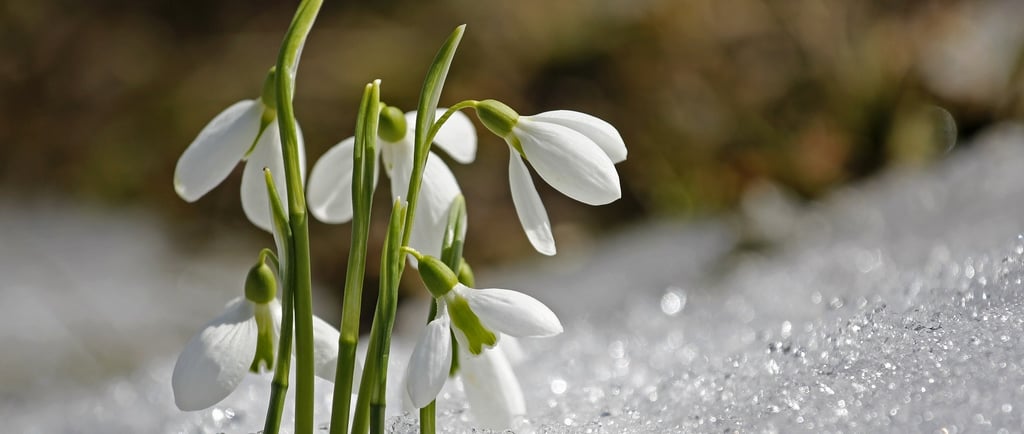❄️🌱 Blooming Through the Frost - The Snowdrop 🌱❄️
This story links to three chapters in Biology— The Plant 🌱, The Leaf 🍃, and The Flower 🌸. Snowdrops are magical winter bloomers, peeking through the snow ❄️ to remind us that life thrives even in the coldest months. Their slender leaves with parallel venation , like green ribbons, gather sunlight even in the weak winter days 🌞, showing how leaves act as the plant’s food factory. Meanwhile, the snowdrop’s corolla or the “little crown” 👑, attracts specialized pollinators brave enough to venture out in the frosty months.🐝 . This story celebrates hope, resilience, and the marvel of adaptation, preparing children for the grand flower explorations of spring 🌼🌷. I wonder… what other flowers bloom in the cold and snowy months? 🌨️✨
BIOLOGY STORIES
1/9/20252 min read


Plants are all around us, big and small, with leaves, flowers, and stems and roots that work together to help them thrive. 🌱 Today, I have a story for a very special plant that blooms when the world is blanketed in snow: the snowdrop! 👏 Snow-drop 👏. This magical flower emerges in the coldest months of January and February, bravely pushing through the frost ❄️and ice, whispering that spring soon will return.🌸
The snowdrop thrives where other plants rest, using its amazing winter superpowers! Its underground bulb is like a tiny treasure chest, storing all the energy and nutrients it needs to grow during the cold months. ❄️🌱While other plants are sleeping, the snowdrop’s bulb is busy working quietly, preparing for its big moment to push through the frosty ground and bloom.🌼✨The secret is in hidden in the snow! The snow itself acts like a soft, protective blanket. ❄️ That keeps the soil underneath from freezing solid, giving the snowdrop just the right conditions to grow. 🌱So, even though the snow feels icy and cold, it helps this little plant grow.
🌨️ First you can spot fresh green slender leaves with parallel venation pushing bravely through the snow , they reveal a clever design.Each leaf is like a tiny solar panel, working to power the snowdrop’s magical bloom. But there’s another secret part helping out growing through the snow : the spathe! This is a new part of the plant, and you may guess what does the name mean 👏 spathe 👏. The word comes from the Greek word spathē, meaning “broad blade,” is like a tiny transparent shield. It wraps around the flower bud, keeping it safe from the biting cold and curious animals 🐾. When the time is right, the spathe gently splits open, peeling back to reveal the snowdrop’s elegant corolla.
And once the conditions are promising—you will notice the flower itself!The little crown 👑is made out of six delicate pieces: three longer outer petals protecting the bloom and three smaller inner petals guiding pollinators 🐞 .These smaller petals aren’t just functional—they’re artistic too! Each one has a tiny green marking, like an upside-down heart 💚, pointing the way to the nectar, the sweet treat hidden deep within the flower. It’s like nature has painted little signs saying, “This way, pollinators!” 🌼✨ The snowdrop’s name is as magical as the flower itself—its botanical name, Galanthus nivalis, means “milk flower of the snow,” capturing its pure white blooms and frosty habitat perfectly. ❄️
But who are these brave visitors? Most bees 🐝 and butterflies 🦋 are still hibernating during the winter months, tucked away in warm, cozy shelters. Instead, the snowdrop relies on hardy winter insects, like certain species of flies 🪰 and beetles 🐞, who venture out on rare mild days. For these winter warriors, the snowdrop is like a small café in the middle of a snowy landscape, providing nourishment for those who dare to walk out of their cozy shelters.
The snowdrop isn’t just a flower—it’s a star of legends and culture! 🌟 In Eastern European folklore, the snowdrop is the first flower of the year 🌼, bringing hope and new beginnings. 🌟 Legend says that when Winter’s icy grip ❄️ felt endless, the snowdrop bloomed to comfort people, promising that spring 🌸 would always follow, no matter how cold it got! 🌱✨.
I wonder… why does the snowdrop bloom so early when most plants are still sleeping? 🌼 Could it be to avoid competition for sunlight and pollinators? And what other plants might you find braving the winter frost and snow ? 🌨️
With Montessori joy,
Vanina 😊

